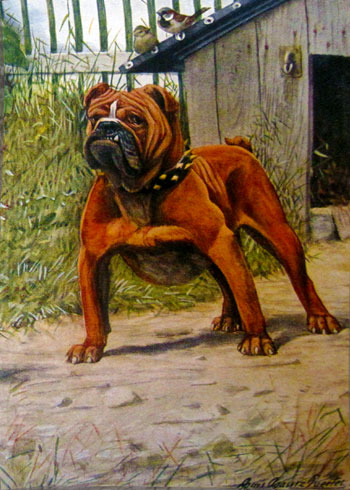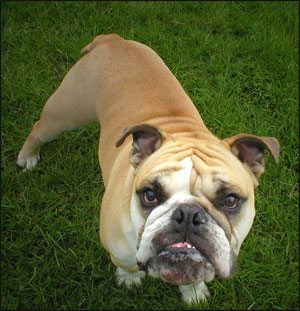Dog Breeds
Dog Tips
Training
Exercise
Medical
Interviews
Miscellaneous
About DB
Contact DB
Resources

Illustration by Louis Agassiz Fuertes
Bulldog
The English bulldog for hundreds of years and in almost every land has typified unflinching courage and unshakable determination. As the lion has been used to represent the majesty of Great Britain, so the bulldog has been used to represent her persistence—her ability to "hang on" until she has accomplished whatever she has undertaken.
As his name implies, the bulldog got his name from the fact that he was used in the old-time "sport" of bull-baiting, which was popular among certain classes in England for at least 700 years, until it was made illegal in 1835. Even after that, occasional matches were continued illegally until 1853, and the actual rings for bull-baiting still remain in several places in England.
The "sport" was usually held at some "garden" maintained for this and similar purposes, or sometimes in a public market-place. Here a bull with a rope about his horns was tethered to a ring bolted to a rock or to a stake driven into the ground. The rope being about 15 feet long, the bull had considerable room in which to move without being able to endanger the lives of the onlookers.
The object of the dog was to seize the bull's nose in his teeth, pin it to the ground and not leave it. He was bred with an undershot jaw and a retreating nose, that he might hang on to the bull and breathe easily at the same time.
The bull, of course, did his best to toss the dog with his horns, and often- succeeded. Pepys, who witnessed a bull-baiting in Southwark in 1666, naively describes it as "a very rude and nasty pleasure."
The dogs were also used to bait full-grown bears and for dog-fighting. For such work they had to be not only strong, but very active They were real and splendid dogs in spite of the barbarous uses they were put to.
The bulldog of today is a grotesque deformity— short-legged, short-winded, short-lived, and barely aisle to reproduce its kind. It is chiefly useful for infusing courageous blood into other breeds, for adding variety to a dog show, and as an example (to be avoided) of what can be done by senseless breeding to spoil a perfectly good dog.
But they haven't quite spoiled him, for he still retains his old-time dauntless courage, and he has a homely smile that would melt the hearts of even the few unfortunates who boast that they hate dogs.
 And here is an appropriate place to register a friendly protest against the arbitrary fixing of points for which dog owners must breed in order to win at the dog shows, without sufficient reference to the requirements of the dog as a working ally of man.
And here is an appropriate place to register a friendly protest against the arbitrary fixing of points for which dog owners must breed in order to win at the dog shows, without sufficient reference to the requirements of the dog as a working ally of man.
No one feels more deeply the debt of gratitude which we owe to the many intelligent and unselfish breeders who, often at great sacrifice of time and money, have given us our long list of useful and beautiful dogs. But there is tendency in the very proper enthusiasm over dog shows and show dogs to forget that the primary object of breeding most dogs is to produce animals which are useful in different fields of activity, and not to conform to a particular standard unless that standard is the one most likely to developdogs fitted in mind and body for the work required of them.
With the idea of making as ugly and surly looking a beast as possible, the present standard for the bulldog demands a type that is all but unfitted for existence, so great are the deformities exacted of this unfortunate dog. Undershot so that he can scarcely eat his food; teeth that should normally meet never being able to do so; the nose so jammed in that breathing through it becomes almost or quite impossible; the shoulders so muscled and legs so put-bowed as to make locomotion difficult, he is indeed a tribute to the art of man in its most perverted manifestation.
The large, square, heavy head has the face deeply wrinkled, the lower jaw three sizes too long for its mate, the nose thumbed back into the face, the eyes very wide-set and low on the face and the ear wrinkled back to form a "rose." A straight-edge laid along the top of the head should touch forehead, eyebrow, nose and lower jaw; the neck is thick and short, the shoulders very wide and low, the back curving up to the hips, which are a little higher than the shoulders. Hind legs strong, arched, with the stifle and toes turned out a little and the hock correspondingly turned in. Brindle is the favorite color, but white, black and white, fawn, red, brown, and even solid black are met with. A good bulldog should weigh from 30 to 40 pounds.
He is a good-natured, gentle creature, in spite of his forbidding appearance, and makes a safe and dependable family dog. When once aroused to anger, however, his tenacity and courage are proverbial, and he justifies every claim that could be made for him, being totally without fear, under whatever odds he may be placed, and apparently insensible to pain, staying at his battle to the very death.
There has been developed in England a socalled "miniature" bulldog with a maximum weight of 22 pounds. A perfect specimen has been described as the larger variety seen through the wrong end of a telescope. As the weight would indicate, he is not a toy, and is highly regarded as a companion by those who require a staunch little dog not quite as active and excitable as most terriers are.
Did you enjoy this article? Let us know what you think by commenting below. Don't forget to Friend us on facebook and subscribe to our twitter feed to stay updated! Thanks for reading, recommend us to your friends! |
